Just because it’s winter doesn’t mean you need to give up seeing beautiful things! Some plants are at their best in the coldest months. So, if you are ready to add some color to your garden at an unusual time of year, we can help. Here are the 15 best winter interest plants for adding color to your yard.
Camellia

Camellia flowers are stunning and don’t start blooming until at least late fall, if not into winter.
©iStock.com/penkanya
This slow-growing evergreen shrub is native to China, Japan, and Korea. Camellia (Camellia japonica) is in the Theaceae (tea) family and is winter hardy in zones 7 to 9. You will need plenty of space to plant these lovely shrubs, as each requires roughly six to twelve feet of space. However, they are well worth the investment in time and space. Camellias attract songbirds and ample pollinators.
Their showy flowers start to blossom in late fall or early winter. The 3- to 5-inch flowers come in several colors, including white, yellow, variegated, pink, and red. Expect the plants to reach up to 10 feet wide and 13 feet tall. They are relatively high-maintenance, so do your research before buying!
Christmas Roses
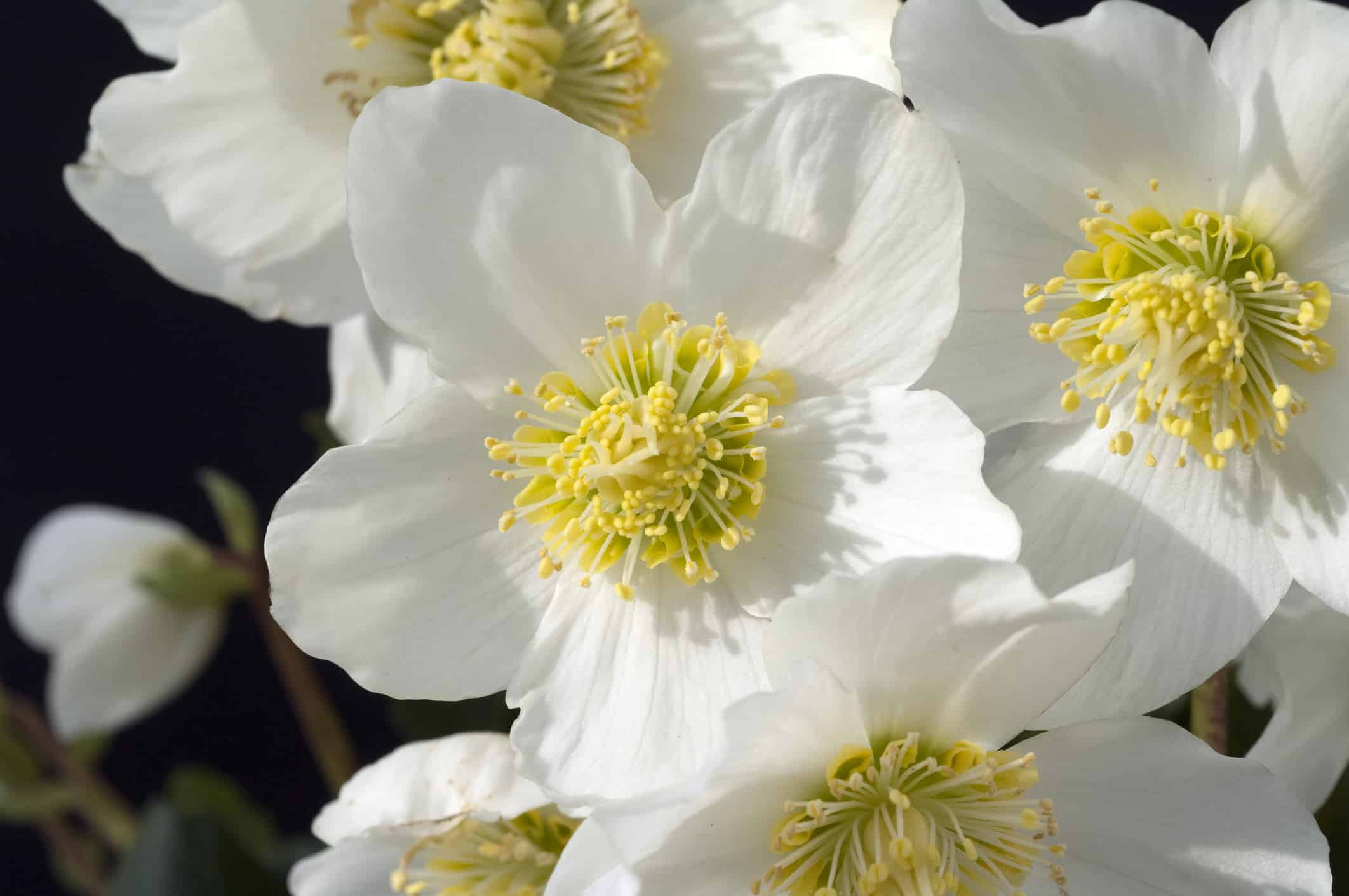
Christmas roses typically start blossoming near Christmas — hence their name.
©emer1940/iStock via Getty Images
Consider planting an evergreen perennial like Christmas roses (Helleborus niger) to add some intrigue to your winter garden. These lovely plants get their name from the time of year they bloom — around Christmas. (This timing may be later in colder environments). They are winter hardy in USDA Hardiness Zones 3 to 8.
Plant your Christmas roses in partial to deep shade to get the best blossoms possible. The solitary flowers are white or pink and grow up to three inches wide. This compact plant only grows to around one foot high and roughly the same width.
There is one important note: all parts of this plant are toxic if consumed.
Crabapple
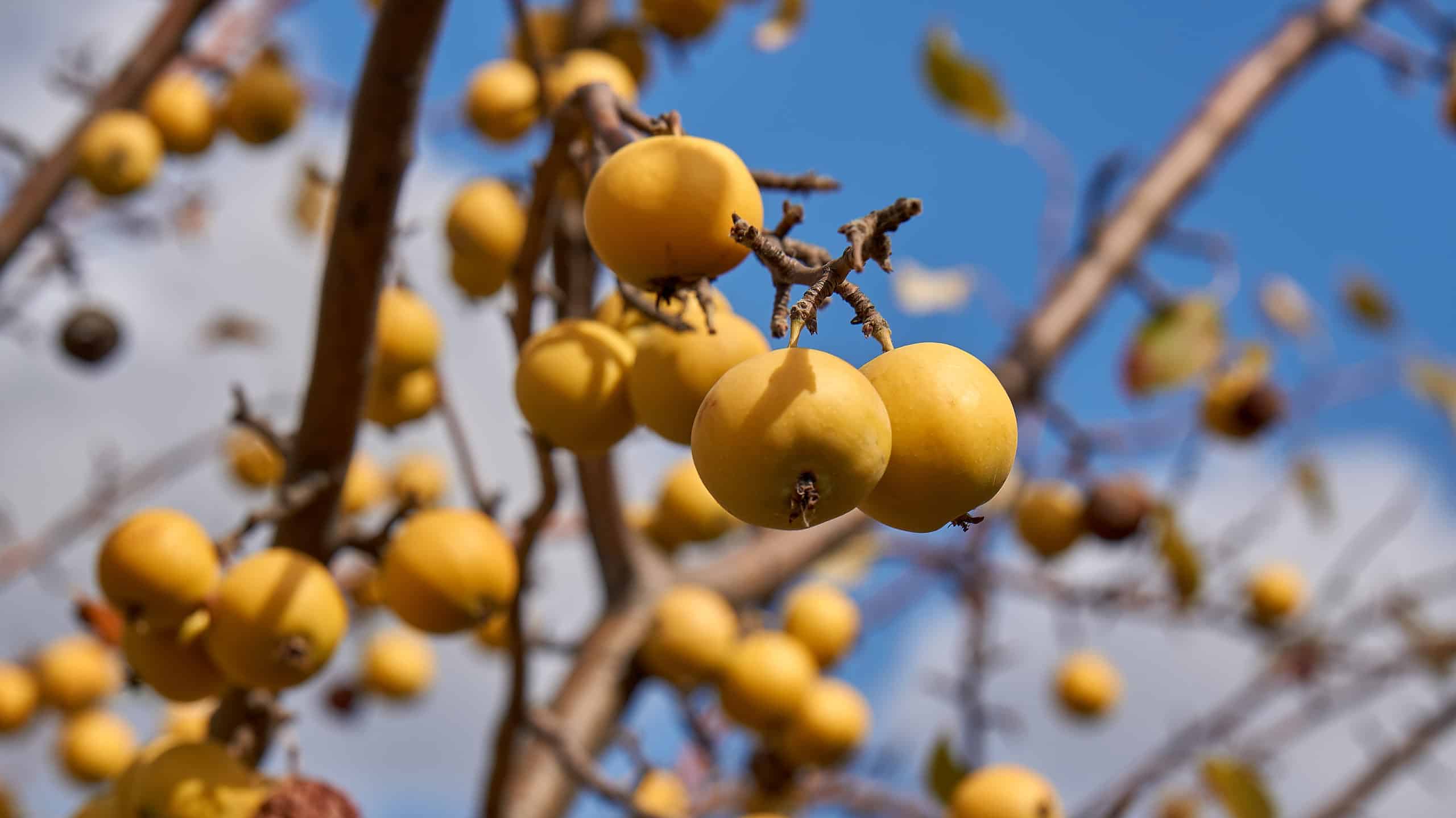
There are several crabapple varities to choose from, and some bear fruit into the winter.
©Igor Sirbu/Shutterstock.com
Do research before purchasing a crabapple (Malus sylvestris) tree if your goal is to plant a showy winter garden addition. While some varieties retain their fruit into the winter, not all do. These deciduous trees are in the Rosaceae (rose) family. They thrive in full sun to partial shade.
Most crabapple trees will produce their flowers in the spring and fruit in the fall. However, the colorful fruit offers a stark, beautiful contrast to the tree’s foliage. Expect the apples to be a few inches smaller than standard apples. However, they make delicious jams, jellies, and pie fillings! These trees attract lots of wildlife, which will fight you for the fruit.
Firethorn
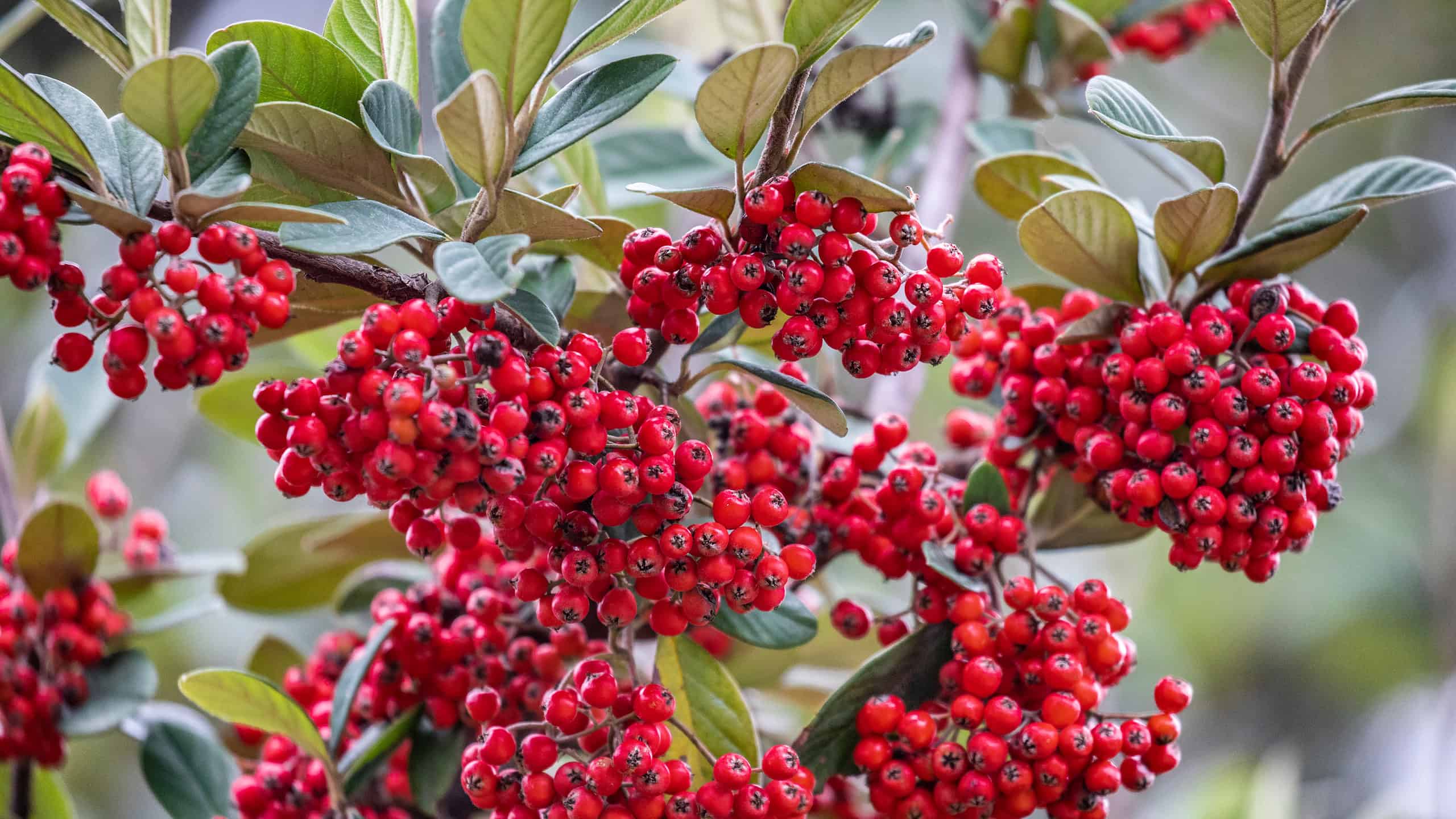
These shrubs are members of the
Rosaceaefamily.
©Mehmet Cetin/Shutterstock.com
Firethorn (Pyracantha coccinea) is a deciduous shrub native to Asia and parts of Europe. These plants grow between six and eighteen feet tall and wide. They are members of the Rosaceae (rose) family and are winter hardy in zones 6 to 9. While firethorns do develop lovely flowers in the spring, the real knockout is the fruit. The berries are orange-red and show up in the fall, often lasting into mid-winter.
This densely packed plant is ideal for hedges and privacy screens. Just beware — the thorns will hurt if you get too close.
Japanese Maple
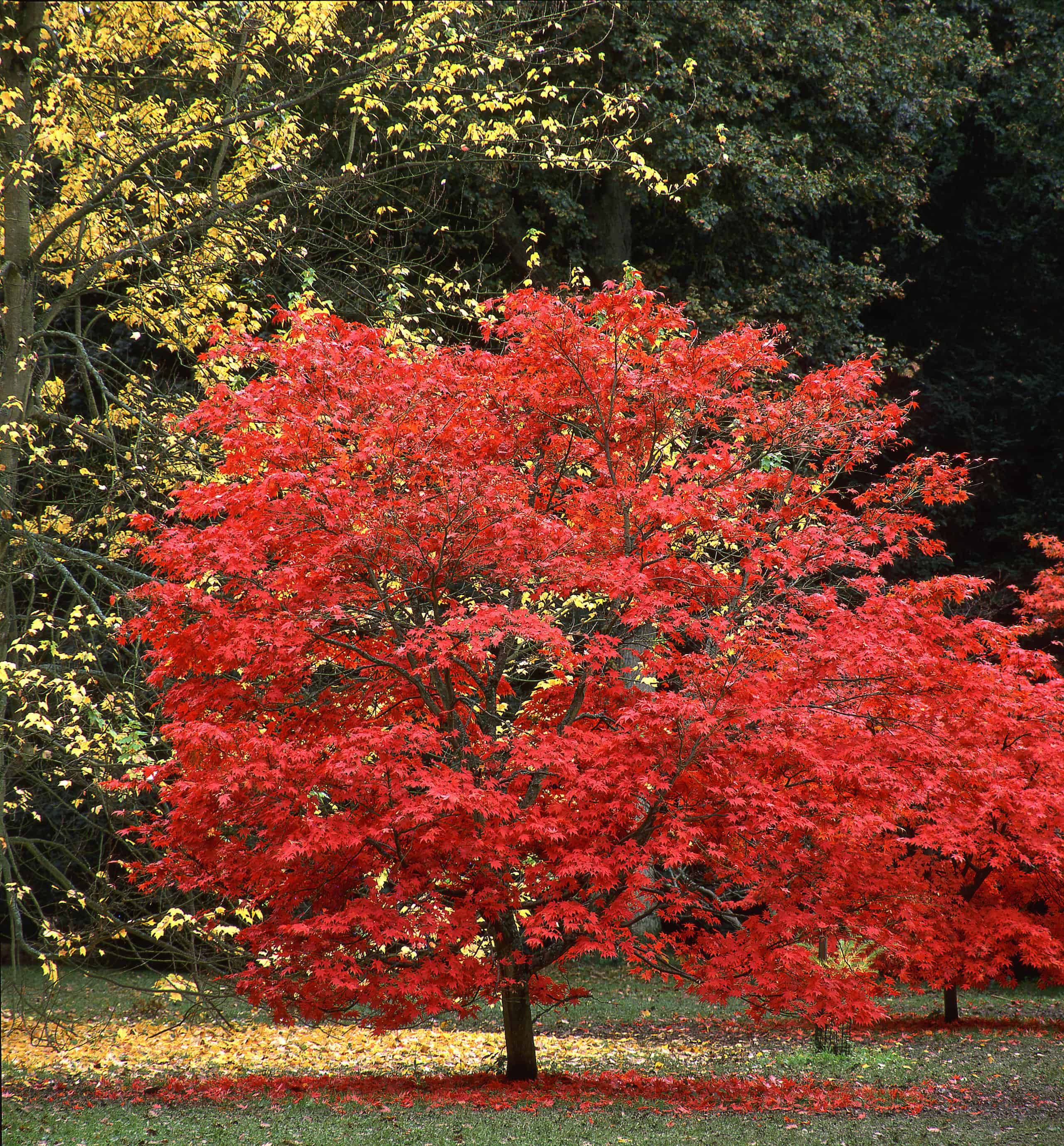
Japanese maple trees have spectacular foliage in the fall.
©iStock.com/Michel VIARD
Those ready to add winter color to their garden without flowers or berries are in luck. Japanese maples (Acer palmatum) do the job with their jaw-dropping foliage. These trees are native to Japan and Korea and are winter-hardy in zones 5 to 8. Since they are trees, you’ll want to leave plenty of room for them. Japanese maples can grow between ten and twenty-five feet tall and wide.
Their red-purple, yellow, or bronze foliage will stun you from fall until early winter.
Mountain Ash
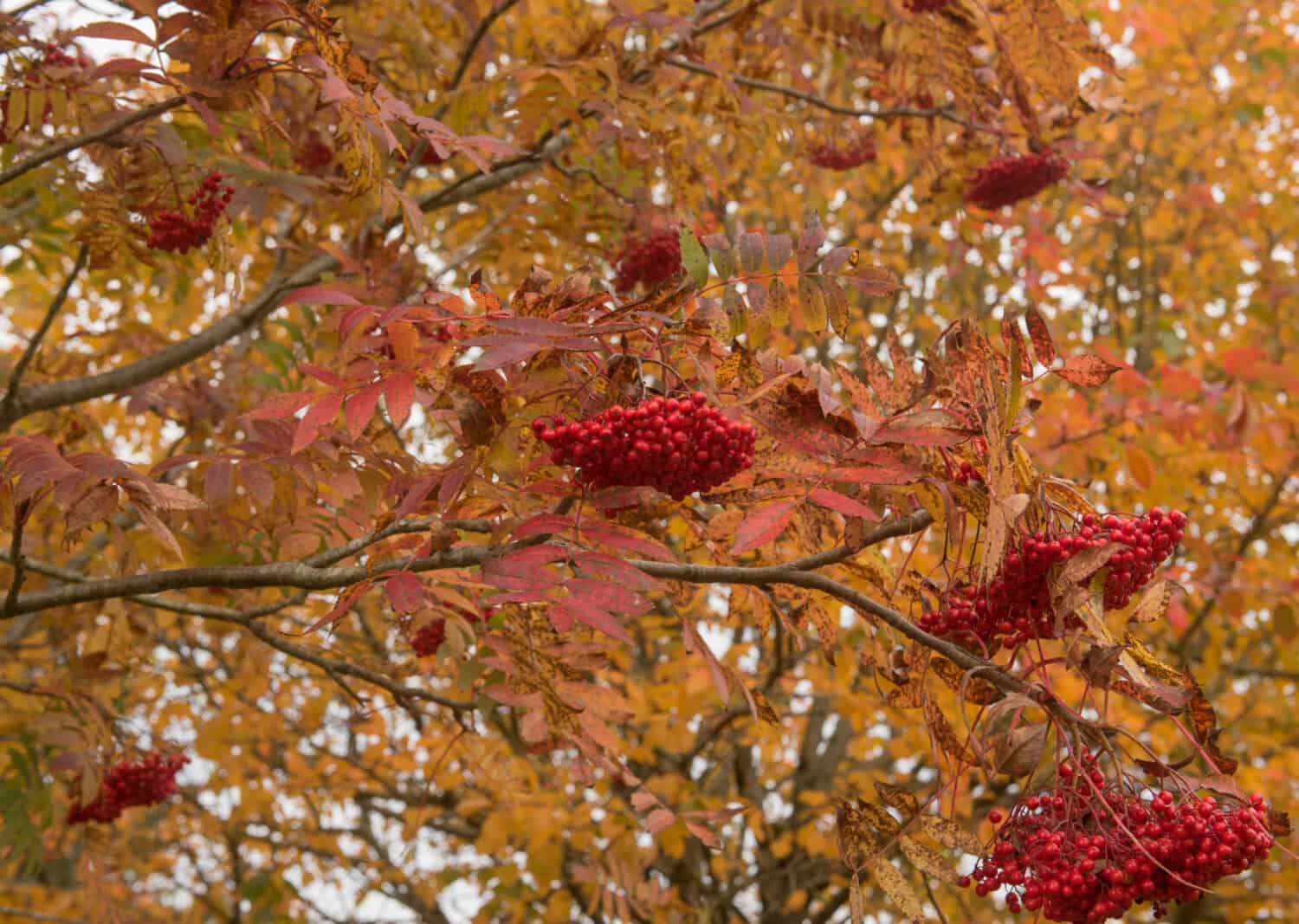
Adding a mountain ash tree (or several) to your yard will bring some serious winter intrigue to your space.
©Peter Turner Photography/Shutterstock.com
This North American native will bring fantastic color to your winter garden or yard. Mountain ash (Sorbus americana) is a deciduous shrub or small tree in the Rosaceae (rose) family. It grows up to 30 feet tall and wide and thrives in full sun. Its blossoms arrive in the spring. However, its bright orange-red fruit offers a stunning winter treat.
The small fruit is less than an inch in diameter but is edible. You may have to fight the birds and small mammals for it though!
Red Twig Dogwood
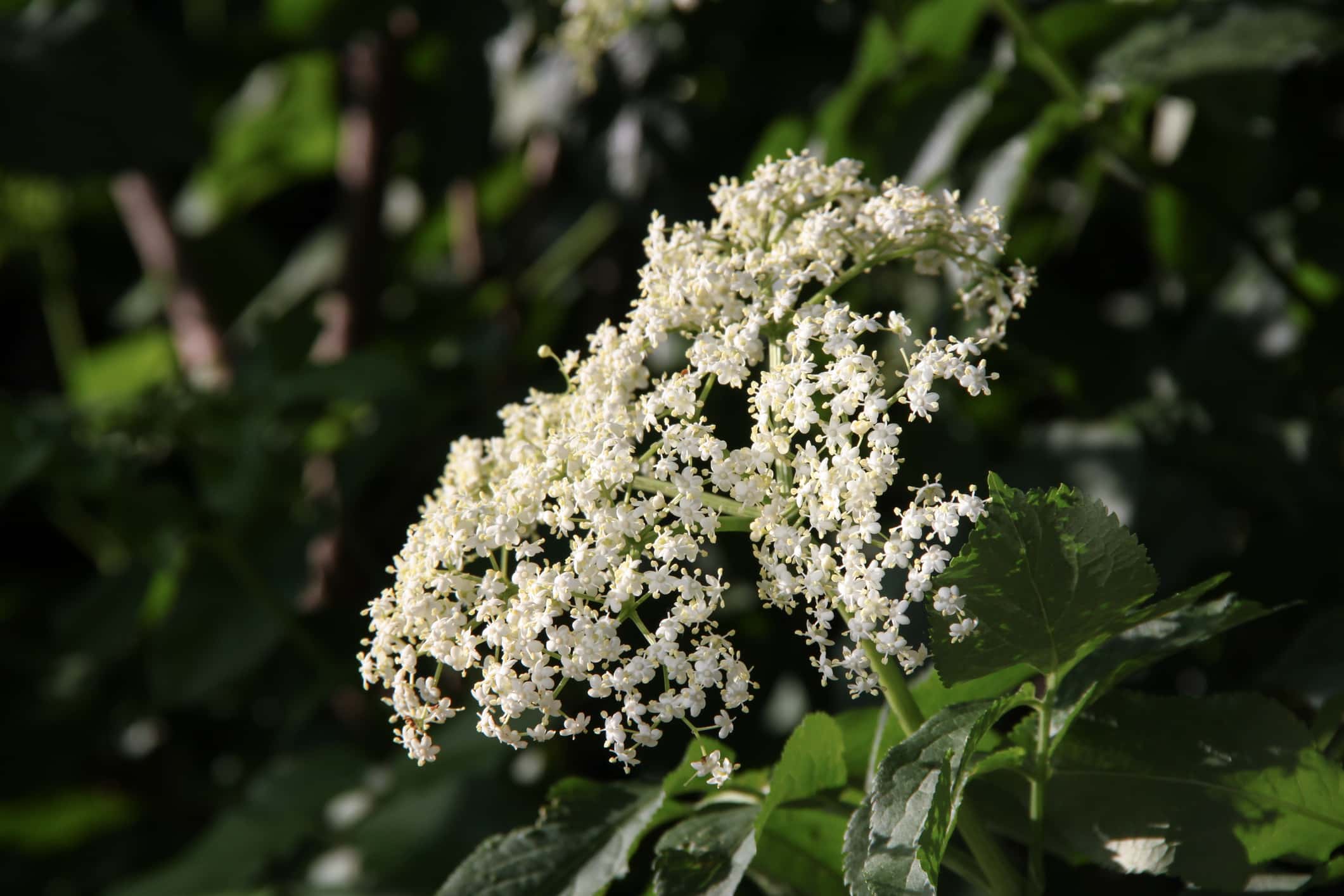
While the red twig dogwood has lovely flowers, it is the stems that truly stand out through winter.
©Barbara Gabay/iStock via Getty Images
Flowers and berries aren’t the only way to add color to your winter garden. The red twig dogwood (Cornus stolonifera) will bring a pop of delightful color differently. After this North American native tree loses its leaves in the fall, its stems turn bright red. So, when it snows, you will get a jaw-dropping treat.
‘Sky Pencil’ Holly

Japanese holly develops gorgeous black drupes in the late fall or early winter.
©Helen Pitt/Shutterstock.com
Another great choice for your winter interest plants collection is this evergreen shrub native to East Asia and Japan. It goes by many names, including ‘Sky Pencil’ holly, Japanese holly, and box-leaved holly (Ilex crenata). While dense and compact, it can grow up to ten feet tall and eight feet wide. The bright green foliage gets offset in the fall and winter by its unique fruit.
The tiny black fruit is less than half an inch in diameter. These drupes provide a valuable food source for wildlife, and pollinators flock to the plant.
Snowberry

These shrubs get their name from the striking white berries that develop in early fall and last until winter.
©Iva Vagnerova/iStock via Getty Images
Snowberry (Symphoricarpos albus) is a medium-sized deciduous shrub that grows up to six feet tall and wide. While its flowers appear in the spring and summer, the plant doesn’t lose beauty in colder months. It develops roughly half-inch-sized drupes in early fall. These persist on the branches even after the foliage drops off. They are bright white and grow in clusters.
This shrub is native to Eastern North America and thrives in hardiness zones 3 to 7. It is also low-maintenance so that you can enjoy its beauty without a ton of effort.
Snowdrop
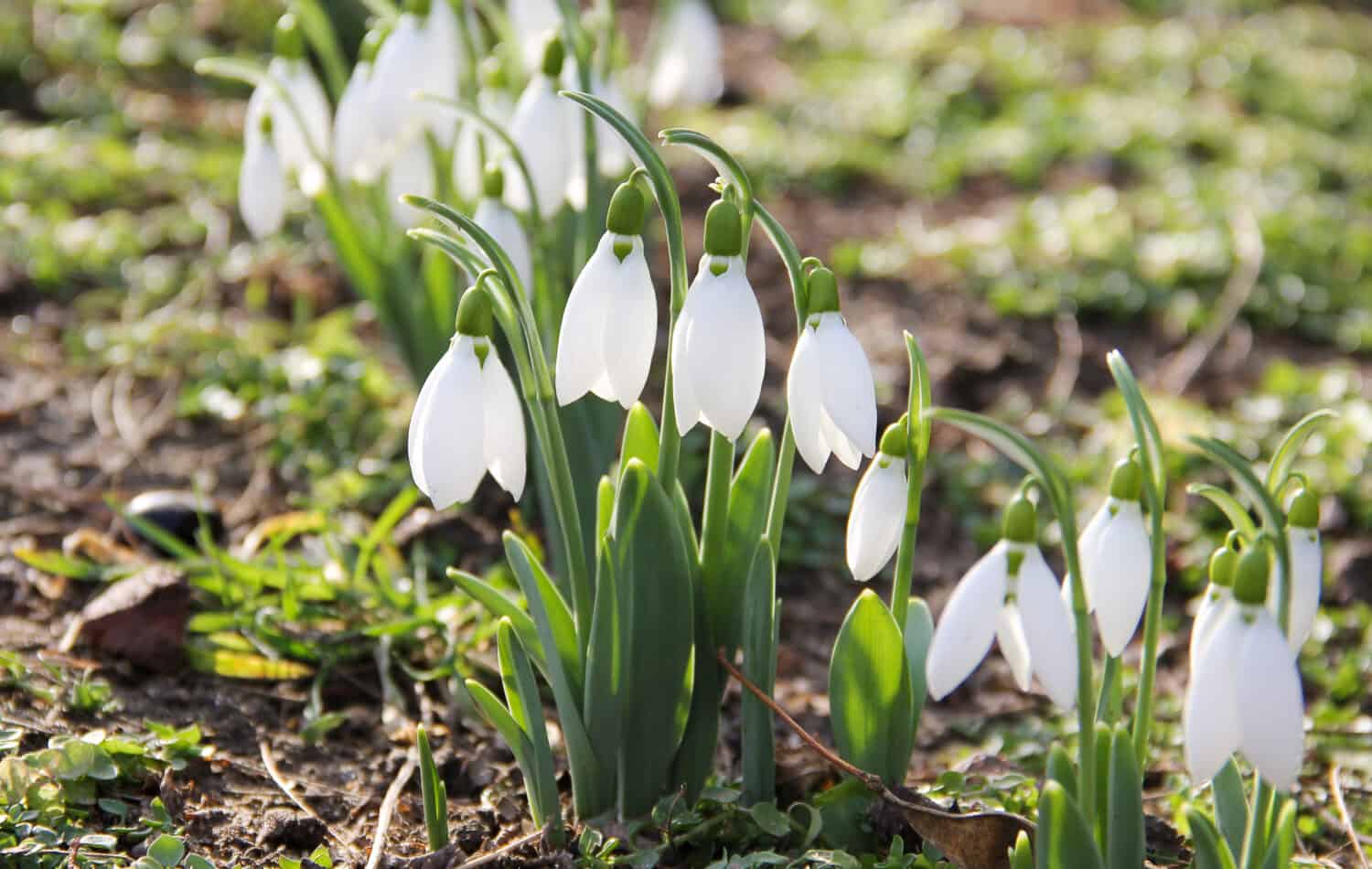
The eye-catching white flowers look like snowdrops and develop in late winter.
©Olesya Myzzz/Shutterstock.com
Plant this stunning option for winter interest plants to enjoy its blossoms well before most other flowers bloom. Snowdrop (Galanthus nivalis) is a perennial well-known for its late winter or early spring bright white flowers. It is native to parts of Europe and prefers colder weather, so it does best in zones 3 to 7. This flower is relatively small, reaching less than a foot tall and wide.
It is low-maintenance and deer-resistant. Plant your snowdrops in a spot that receives partial to full sun.
Star Magnolia

Magnolia trees produce gorgeous flowers, one of which belongs to the star magnolia. It is bright white and begins blossoming in late winter.
©Jeremy Smith/iStock via Getty Images
This jaw-dropping tree is native to Japan but is at home in USDA Hardiness Zones 4 to 8. Star Magnolia (Magnolia stellata) trees grow up to 20 feet tall and 15 feet wide. They produce showy white flowers starting in the late winter. These flowers have a distinctive star shape.
Star Magnolia trees need well-draining, highly nutritious soil and do not do well in poor soil or extreme conditions. Plant it in a spot that is sheltered from high winds but receives at least partial sun daily.
Winterberry Holly
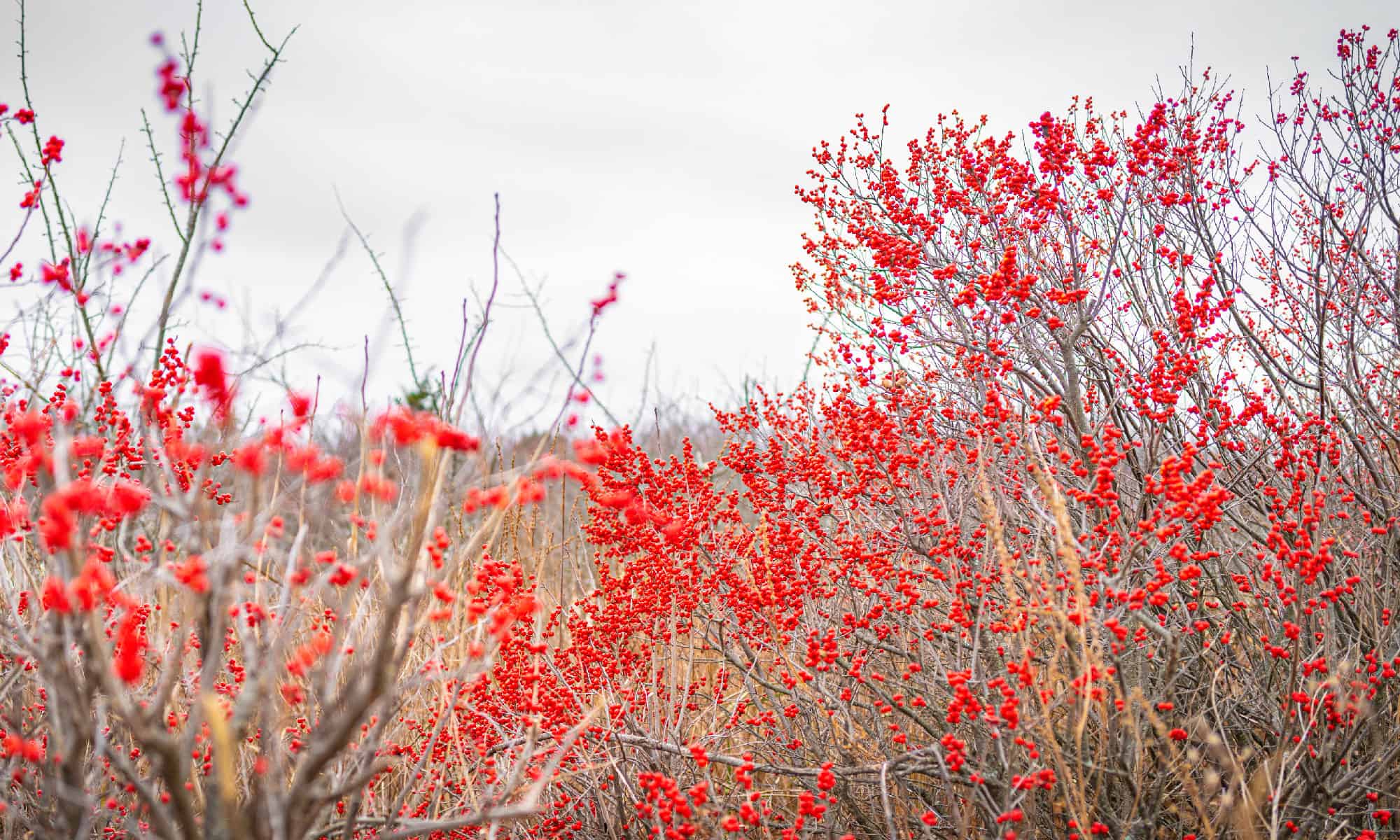
The bright red berries of the winterberry holly tree provide a stark contrast against foliage-free stems.
©iStock.com/Sanghwan Kim
One of the most impressive winter interest plants is the aptly named Winterberry holly (Ilex verticillata). It is native to Central and Eastern North America and does best in zones 3 to 9. This low-maintenance plant is ideal for hedges. But it does need a fair amount of water. As long as you keep the soil damp, your winterberry holly will thrive. Its flowers arrive in the summer and are then replaced by stunning red berries.
Birds flock to the showy berries so you can get an extra show in the winter. They stick around on the plants through most of winter and sometimes into the spring. Leave some space for these shrubs, which reach up to twelve feet high and wide.
Winter Hazel
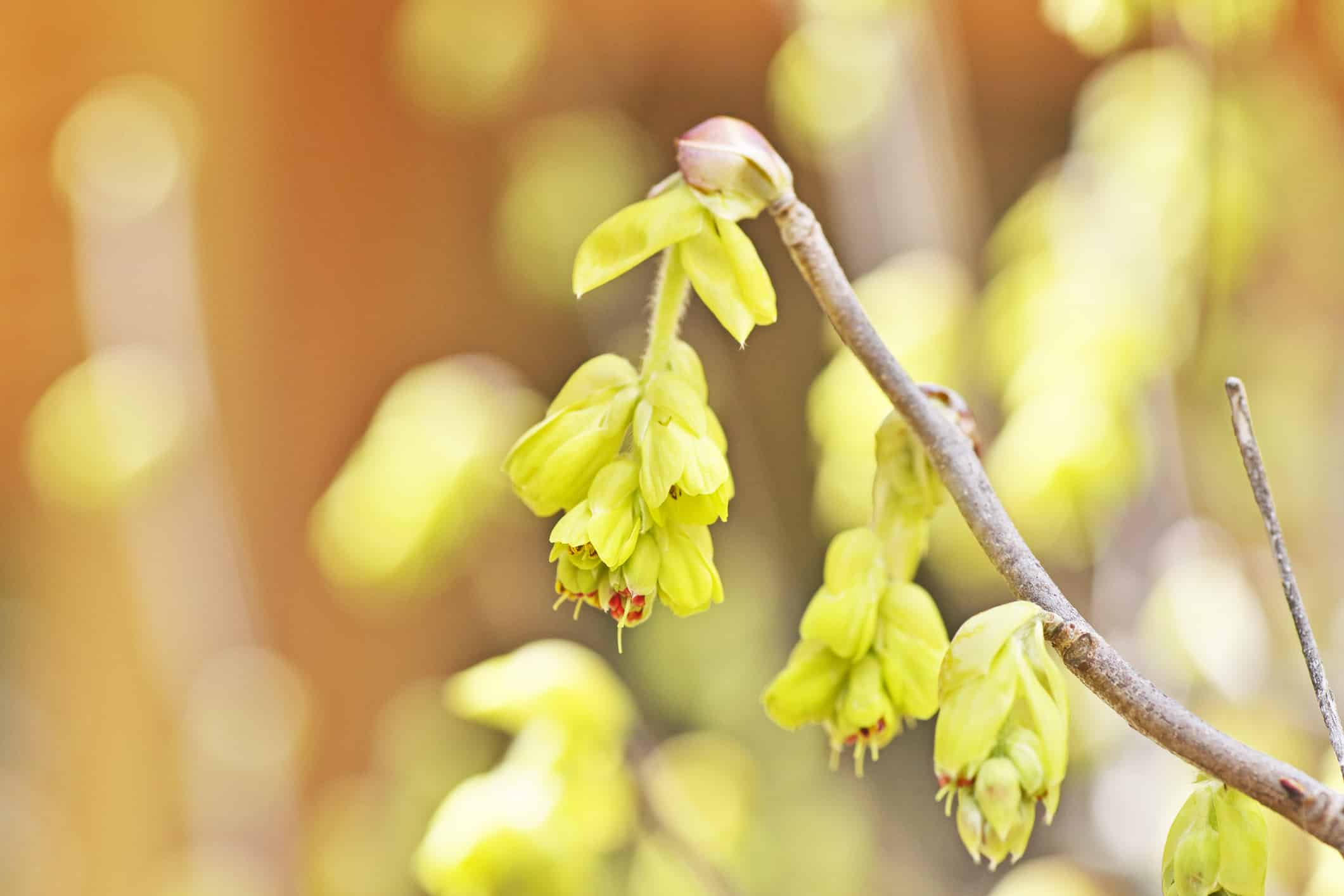
The yellow flowers of winter hazel stand out against bare branches.
©igaguri_1/iStock via Getty Images
While winter hazel (Corylopsis pauciflora) isn’t the most ornamental plant, it does provide lovely yellow blossoms starting late winter. It is a deciduous shrub native to Taiwan and Japan and is USDA Hardiness Zones 6 to 8.
Winter hazel grows to between four and six feet tall and wide. Clusters of fragrant flowers grow out of the dense shrub in groups of two to five. This plant requires partial to full sun to thrive and needs protection from high winds.
Winter Jasmine

Winter jasmine is a vining shrub that produces shockingly yellow flowers in the winter.
©SzabolcsKiss/iStock via Getty Images
This vining shrub is native to China. Winter Jasmine (Jasminum nudiflorum) reaches up to 6 feet wide and 15 feet long. It thrives in warmer climates, including zones 6 to 10. Because of its trailing nature, this plant makes an excellent ground cover. Unlike some of the other winter interest plants, winter jasmine produces bright yellow flowers instead of the standard white or red.
It is a low-maintenance plant that only needs partial shade, though it does best in full sun. Plant it near a wall or border for the most intriguing growth.
Witch Hazel
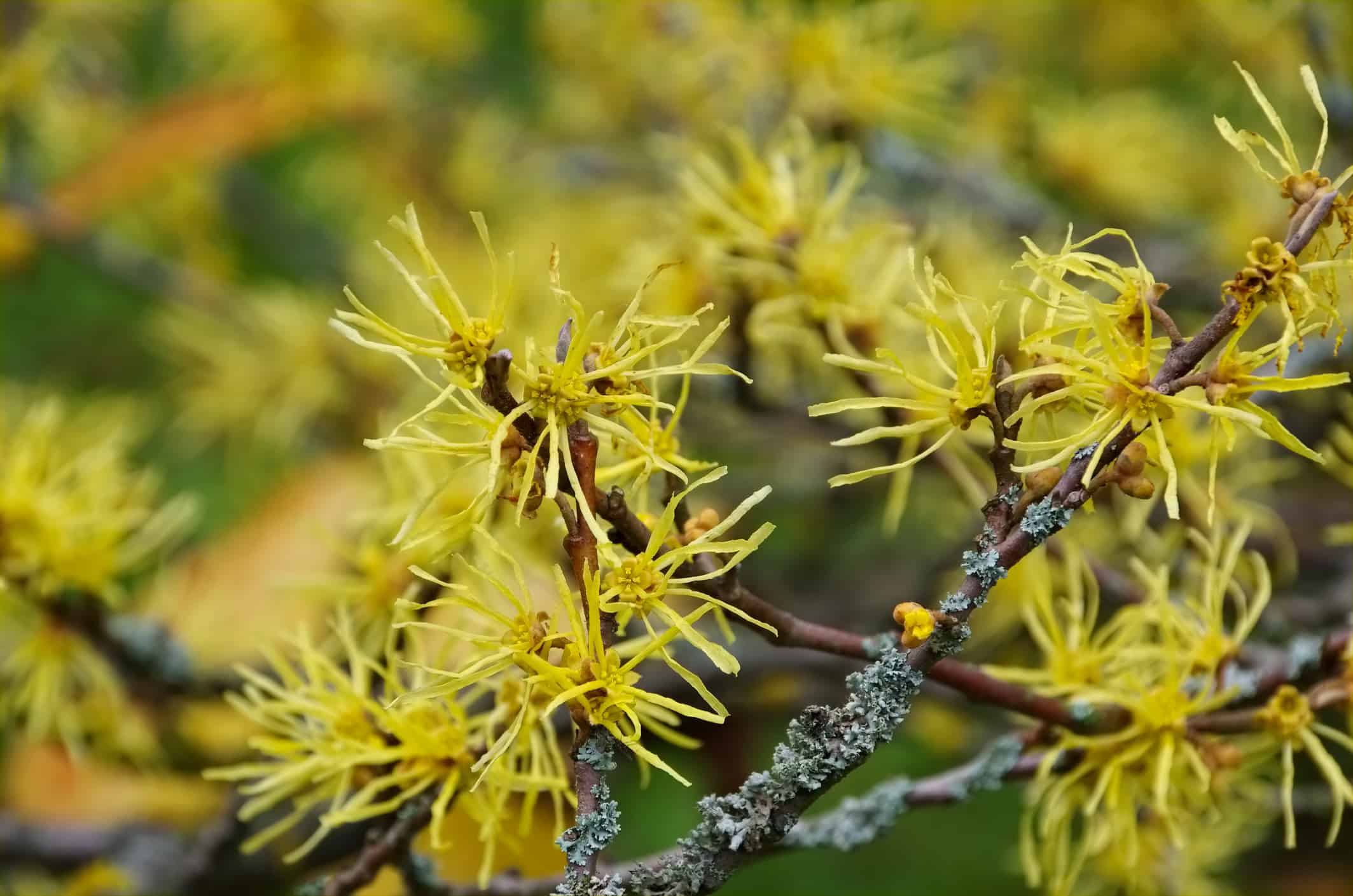
These lovely shrubs make excellent hedges and provide a unique addition to your winter garden.
©LianeM/iStock via Getty Images
Witch hazel (Hamamelis virginiana) is a deciduous shrub native to Eastern North America. The plants grow between fifteen and twenty feet high and wide. Their size and shape make them ideal for hedges or garden edges. They are tolerant of deer, clay soil, and erosion. Witch hazel is a low-maintenance plant that makes it top on the list of winter interest plants.
It develops lovely yellow flowers in late autumn, which typically last until December. They are fragrant and have ribbon-shaped petals. Plant your witch hazel in a spot that receives partial shade to full sun. The plants need moderate water. And as long as they are taken care of properly, you will have plenty of birds flocking to your shrubs.
Summary of the 15 Best Winter Interest Plants for Adding Color to Your Yard
| Number | Plant | Scientific Name |
|---|---|---|
| 1 | Camellia | Camellia japonica |
| 2 | Christmas Roses | Helleborus niger |
| 3 | Crabapple | Malus sylvestris |
| 4 | Firethorn | Pyracantha coccinea |
| 5 | Japanese Maples | Acer palmatum |
| 6 | Mountain Ash | Sorbus americana |
| 7 | Red twig dogwoods | Cornus stolonifera |
| 8 | ‘Sky Pencil’ Holly | Ilex crenata |
| 9 | Snowberry | Symphoricarpos albus |
| 10 | Snowdrop | Galanthus nivalis |
| 11 | Star Magnolia | Magnolia stellata |
| 12 | Winterberry Holly | Ilex verticillata |
| 13 | Winter Hazel | Corylopsis pauciflora |
| 14 | Winter Jasmine | Jasminum nudiflorum |
| 15 | Witch Hazel | Hamamelis virginiana |
The photo featured at the top of this post is © Alina_Miyazaki/Shutterstock.com
Thank you for reading! Have some feedback for us? Contact the AZ Animals editorial team.







